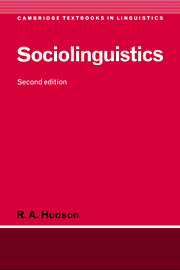2 - Varieties of language
Published online by Cambridge University Press: 05 June 2012
Summary
Introduction
Global and specific statements
Our purpose in this chapter is to see how far it is possible to describe the relations of language to society in terms of ‘global’ linguistic categories such as ‘language X’ or ‘dialect Y’ and global social categories like ‘community Z’. To the extent that it is possible, the relations concerned can be handled in terms of these global categories, and need make no reference to the individual linguistic items, such as items of vocabulary, contained in ‘language X’ or to the individual members of ‘community Z‘. On the other hand, we shall see that it is not always possible to do so without loss of accuracy and that at least some linguistic items are socially unique – that is, there are no other items that are used by precisely the same range of speakers or under precisely the same range of circumstances. Similarly, as we saw in the last chapter, we may assume that every individual in a community has a unique language when we probe the details. To the extent that different linguistic items have different relations to society (in terms of people and circumstances), it is obviously necessary to describe these relations separately for each item. Thus on the one hand there are statements about global categories, like whole languages, and on the other hand there are statements about individual linguistic items; and in each case the statement refers to speakers either as members of some community or as individuals.
- Type
- Chapter
- Information
- Sociolinguistics , pp. 20 - 69Publisher: Cambridge University PressPrint publication year: 1996

